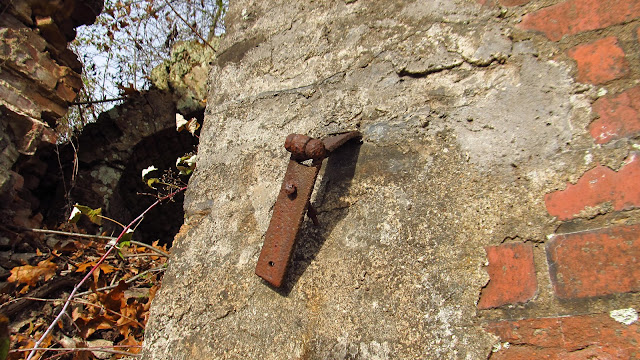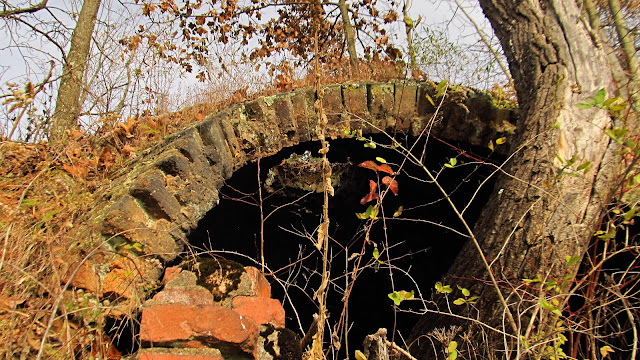Well it's officially Coke Oven Season once again! Best wishes to you all. Today we headed out for something I've been wanting to get to for the past few years. Thanks Nick and Tracey for letting us on your amazing property! Hecla No. 3 was the third installment in the Hecla trilogy. The first being nearby Hecla No. 1 at Hecla and the second being Hecla No. 2 at Trauger. Hecla No. 3 was first fired in 1904 by the Hecla Coke Company. In 1905 the H.C. Frick Coke Company took possession of all three of the plants. The three Hecla coke plants wouldn't last long past the 1920's but like Trauger, there was evidence of the ovens at No. 3 being operated at some later point by somebody.
The Hecla Coke Company was a company composing of two brothers from the Thaw family, Benjamin and William Thaw Jr. and the Darsie brothers. The company was formed in the early 1880's and was absorbed by Frick in 1905. The Thaw's father, William Thaw Sr. was a coal baron that owned much of the land around Mt. Pleasant Township. He left to his heirs a "coke trust" that still appears on modern day property deeds. Benjamin Thaw's son was William Thaw II, a World War 1 flying ace who is believed to be the first American to engage in aerial combat in the war. He was also the first to fly up the East River in New York City under all four bridges. The Thaw family also had its controversies. I wrote about it in an earlier post I did about Carpentertown.
 |
Benjamin Thaw |
The company houses where the workers at Hecla No. 3 lived is a now gone section of town called "Goat Hill". Goat Hill is now part of the Hecla Sportsman's Club, the patch town was dismantled in the early 1930's.
 |
A couple photos of the Hecla No. 3 shaft mine. (photos courtesy of Ray Washlaski) |
 |
Map sketch showing the detail of the No. 1 and No. 3 mines at Hecla (courtesy of Ray Washlaski). |
Hecla No. 3 Coke Works contained 300 ovens in one bank and one block. The mine was served by the Hecla spur of the Sewickley Branch of the Pennsylvania Railroad. This spur served numerous mines and coke works along its route to Hecla. Today the bank ovens are all extant in varying condition and most of the block ovens are also still here. A portion of the eastern section of the block has been removed due to construction. The majority of the ovens still remain. We found evidence that the ovens had steel doors and weren't bricked up after they were charged. These ovens also sit much higher than most places we have visited. These two things are indicative of a later era coke plant and that the ovens were mechanically pulled.
 |
The easternmost section of the bank ovens. |
 |
The bank ovens. |
 |
This is the current end of the block. This is not the original end. |
 |
This and the following photos are all of the southern portion of the block. |
 |
Ray Washlaski and Geno "Mr. Standard" Kowalewski checking out the ovens. |
 |
Some nice door blocks remaining on this oven. |
 |
A nice piece of steel sticking out of this oven. We believe this was part of the steel door mechanism. |
 |
Looking out of an oven at Ray and Archbishop Standard. |
 |
A really nice example of clay packed insulation between the ovens. |
 |
A broken "1" brick laying around. |
 |
The western portion of the bank. |
 |
This section contains the most intact oven. The odds and ends of the construction (terracotta and concrete block) indicate later usage. |
 |
West of this oven are a couple nearly buried ovens and then they end. |
 |
All kinds of stuff going on here. |
 |
Partial front remaining on this one. |
 |
These are all still on the bank. |
 |
Looking between the bank and the block. |
 |
This concrete wall running along the bottom of the bank appears to have stone blocks behind it. We noticed it in a broken section of concrete. |
 |
These next few are on the block running beside the bank. |
 |
Steps cut into the side of the block. |
 |
A whole mix of construction materials here. |
 |
All along the bank ovens were these notches. We aren't entirely sure what they were but considered that they might have been used for the track that the coke pulling machine ran on. |
 |
And here is the smoking gun in our theory that these ovens had steel doors. A nice big hinge hanging off the side of the oven. |
 |
A nice intact beehive on this oven. |
 |
Most of these ovens were full of coke ash. This one was especially full. |
And that's it for Hecla No. 3.
Standard No. 3
After this we ran over to Standard No. 3 to see what remains of the old mine site. From what I've been told, Standard No. 3 was basically where mine waste was removed from the massive Standard Mine complex. I'm not going to get too far into the history of this right now. This is strictly Geno "Mr. Standard" Kowalewski territory. This is where he got the name Mr. Standard. Geno is doing extensive research of the Standard mines. Long story short, the Standard Mines and their massive coke works (999 ovens) were the pride of the H.C. Frick Coke Company and was a state of the art system dating back to 1886. The ovens have long been removed and the land has been reclaimed. A few of the mine buildings remain around Standard and Standard Shaft as well as most of the company houses. I'm going to let Geno write a post soon because there is nobody around Mt. Pleasant that knows more about this than he does.
Also, thanks Mike for letting us on your land to look at these ruins and play with your animals!
Here's an old photo of Standard No. 3.
 |
Photo courtesy of Ray Washlaski |
 |
Photo of the school with the shaft head frame in the background. Photo courtesy of Mt. Pleasant Historical Society. |
 |
A couple more of the spring house. |
 |
This is at the mine site. I think this is the back wall to the boiler house. |
 |
Here's why. The arched oven/fireplace appears that it would be the bottom of the smokestack shown in the old photo. |
 |
Closeup of the boiler. |
 |
More from what I believe to be the boiler house. |
 |
Your basic building ruins. Geno is working on figuring this all out. |
 |
I love seeing the red bricks that are in the old photo. |
 |
A little bit of the slate dump and Ray. |
 |
Ray is standing on a huge thick concrete slab. |
 |
Looking behind this site. |
 |
Another big concrete pad. |
 |
We believe this is where the hoists for the shaft sat. |
 |
Mr. Standard on another slab. |






































































Nice!!!!
ReplyDeleteThank you for posting these photos. Very interesting! My great great grandparents lived in Hecla from 1856 until about 1865 (after the Civil War) Trying to find out what it was like during that time.
ReplyDeleteI played in those ovens and swam in the pond as a kid. My grandmother lived in a company house that still exists. My fathers side of family worked in company store. My mother’s side were miners.
ReplyDelete